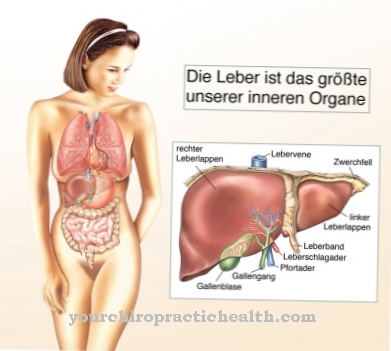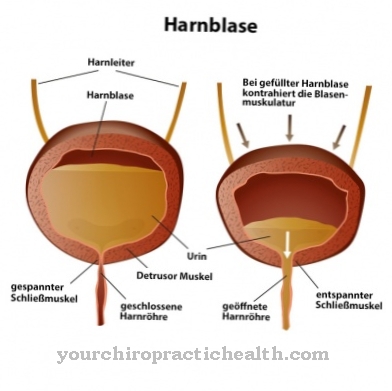At the Fraser Syndrome it is a very rare genetic disease that is characterized by several physical malformations. The extent of the individual malformations is not uniform, so that in addition to cases of stillbirths and children who die immediately after birth, there are also those affected with normal life expectancy. The therapy depends on the type of malformation.
What is Fraser Syndrome?

© vladimircaribb - stock.adobe.com
The Fraser Syndrome was first described in 1962 by the British human geneticist George R. Fraser. Due to one of its main symptoms, the closed fissure of the eyelids, this disease was initially referred to as cryptophthalmos syndrome. More cases were diagnosed in the following years.
In very many cases, in addition to cryptophthalmos, adhesions of neighboring fingers or toes (syndactyly) were found. Therefore, the synonymous term cryptophthalmos syndactilia syndrome was often used. Other synonyms of the disease include Meyer-Schwickerath’s syndrome, Ullrich-Feichtiger syndrome or Fraser-François syndrome.
The term Fraser Syndrome, named after the American human geneticist Victor Almon McKusick, became the main term. In total there are about 150 case reports of this syndrome. It was recognized that there are different forms of the individual malformations. Some sufferers only suffer from cryptophthalmos without any further physical deformities.
In other cases, a variety of dysmorphisms occur. The disease has different main symptoms and side symptoms, with the life expectancy of the individual patients also being different. 25 percent of the children affected are stillborn. Another 20 percent of patients die of kidney or larynx malformations in the first year of life. However, most people have a normal life expectancy.
causes
An autosomal recessive gene mutation is a possible cause of Fraser syndrome. In the majority of cases, there is a genetic defect in the FRAS1 gene, which is located on chromosome 4. Other possible affected genes are GRIP1 on chromosome 12 or FREM2 on chromosome 13.
The FRAS1 gene codes for a protein that belongs to the extracellular matrix. The lack of certain proteins in the extracellular matrix leads to imbalances in the growth processes during embryogenesis. The inheritance of all affected genes is autosomal recessive. This means that the sick person must be homozygous for two defective genes.
If the mutated gene is present only once, the disease will not break out. The syndrome can only be inherited if both parents have at least one defective gene each. Therefore, this syndrome accumulates in the offspring of related parents who have this particular genetic defect.
Symptoms, ailments & signs
Fraser syndrome is characterized by the appearance of various major and minor symptoms. A confirmed diagnosis can be assumed if either two main symptoms and one secondary symptom or one main symptom and four secondary symptoms appear.
The main symptoms are the lack of eyelid clefts (cryptophthalmos), malformations of the organs of the urogenital tract such as the kidneys or the genital organs, adhesions of neighboring fingers or toes (syndactyly) and malformed or missing tear ducts.
The secondary symptoms include small-headedness (microcephaly), wide eye relief (hypertelorism), narrowing or absence of the larynx, immature fetal lung (pulmonary hypoplasia), widening of the pubic symphysis and skeletal abnormalities. Malformations of the auricles, lips or palate are also observed, as is the displacement of the navel or nipple.
Cognitive impairment was previously assumed to be another symptom. However, this has not been confirmed. The prognosis of the disease depends on any malformations of the kidneys, the larynx or the lungs. These cause the high rates of stillbirths and infant mortality. Otherwise, life expectancy is not restricted.
Diagnosis & course
In addition to the medical history, the diagnosis mainly relates to the combination of the main and secondary symptoms. The main focus is on examining the eyes, kidneys, larynx and lungs. Fraser syndrome can be diagnosed prenatally with the help of ultrasound exams. Echogenic lungs can be detected, which indicate a narrowing or closure of the larynx.
The constantly forming fluid can no longer flow back into the lungs due to the narrowing of the larynx and thus forms a congestion, which is also known as fetal CHAOS (Congenital High Airway Obstruction Syndrome). "Congenital High Airway Obstruction Syndrome" means "constriction of the upper airways".
This condition can lead to stillbirth and is considered a medical indication for a possible termination of the pregnancy. The prenatal diagnosis also includes human genetic examinations via a chorionic villus sampling or amniocentesis.
Complications
The Fraser syndrome is based on a genetic defect, a causal, curative treatment is therefore not possible. Due to the rarity of the syndrome and the high mortality rate of those affected (almost a quarter of those affected die before birth, a further quarter in the first year of life), therapeutic approaches and complications are inadequately described.
Survivors are usually treated surgically, depending on how they are affected. The most common complications in the treatment of Fraser syndrome are therefore the general risks associated with surgery. These include, for example, leg vein thromboses (blood clots in the legs, occlusion of a pulmonary vessel (pulmonary embolism), nerve injuries and infections. Postoperatively, there is an increased risk of wound healing disorders including gangrene.
If left untreated, the common symptoms of Fraser syndrome can seriously affect the general life of those affected. Untreated microphthalmia (or anophthalmia) results in complete loss of vision that may be weak. If a cosmetic correction of the eyes is not carried out (e.g. the insertion of an eye prosthesis or the correction of the strong squint), psychological impairments up to the severity of depression are the main consequences.
If the syndactyly (fingers and / or toes that have grown together) remains untreated, the motor skills are severely impaired - depending on the severity, grasping, holding a pen or walking is hardly possible. The renal agenesis often associated with Fraser syndrome, if left untreated, leads to the death of the patient.
When should you go to the doctor?
Physical abnormalities that deviate from the norm should always be clarified by a doctor. The human body has a basic structure, the deviation of which is an indication of a disease. Adhesions, malformations or growths are considered unusual and should be examined by a doctor. If there are changes in the human skeletal system, a doctor's visit is necessary, even if there are no further complaints.
Malformations, ossification or restrictions in the range of motion must be assessed by a doctor. If the toes and fingers cannot be moved individually, if they have changed due to a different shape or if the affected person has webbed hands and feet, it is advisable to consult a doctor.
If the interpupillary distance is unusual, the larynx is missing or there are narrowing in the throat, a doctor is needed. Deformities of the face, especially the ears, eyes, nose or lips, should be examined medically. If the palate changes, a doctor is also needed, as it can lead to problems with food intake.
If the navel or nipples are in different positions on the body, these features should be presented to a doctor. Deviations in possible joint movements or visual changes in the joints are considered unusual and should be examined by a doctor. If individual systems malfunction due to existing deformations, a doctor is required.
Doctors & therapists in your area
Treatment & Therapy
The kidney and larynx malformations are the main causes of death in Fraser syndrome. Therefore, if there is a malformation of the larynx after the birth, a so-called tracheotomy must be performed immediately. During a tracheotomy, surgical access to the windpipe is created to ensure that the patient is ventilated.
In later years, depending on the situation at hand, the function restoration can be revised. Unfortunately, the absence of both kidneys is incompatible with life. In this case, treatment is no longer possible. With unilateral renal agenesis, however, the function of one kidney is retained. Furthermore, a surgical opening of the eyelid fissures is aimed at. However, this operation only makes sense if the eyeballs are present.
Outlook & forecast
Fraser syndrome is an extremely rarely diagnosed disease worldwide. There are hardly more than 150 documented cases in which the diagnosis has been made. Most patients so far have a short life expectancy. Due to the serious malformations, they die in the womb, immediately at birth or shortly after giving birth. These children suffered from severe malformations of the larynx or kidneys.
Since the physical malformations occur individually, there are also sick people who do not experience any significant reduction in life expectancy. Many mutations can be optimized in surgical interventions after birth, so that an improvement in quality of life is made possible.
The patient has a good prognosis for malformations of the eyelid fissures, tear ducts or adhesions of fingers and toes. Corrective measures can already be taken in the first few years of life within the growth and development process. The desired changes are made at the latest with the end of physical growth.
A complete cure is not possible with the genetic disease. Human DNA cannot and must not be changed. Nevertheless, the symptoms can be treated well and adequately with the available therapy and treatment options. Malformations of the genital organs or organs of the urogenital tract can lead to secondary diseases. In some cases, the patient is dependent on donor organs.
prevention
Fraser syndrome is genetic and often occurs in related marriages. If there is a family history, genetic counseling and, if necessary, a DNA test should be used if you wish to have children. In addition, prenatal examination methods are available that can be used to diagnose Fraser syndrome prenatally.
Aftercare
As a rule, there are no special follow-up options available to those affected by Fraser syndrome, as it is a genetic disease. The patient is therefore dependent on purely symptomatic treatment of this disease in order to prevent further complications and to avoid a reduced life expectancy. Self-healing is not to be expected in Fraser syndrome.
With symptomatic treatment, normal life expectancy can usually be maintained. In most cases, the treatment of this complaint is resolved by surgery. There are no particular complications and ventilation can be ensured again. After this laborious procedure, the person affected has to rest and take care of the body.
No more strenuous or stressful activities should be carried out here. Bed rest should be strictly observed. Since Fraser syndrome can also damage the kidneys, regular examinations by an internist are very useful to prevent this damage.
The eyes should also be examined and treated regularly. Since Fraser syndrome can also have a negative effect on the psyche of the person affected, the support and help of friends and family is very useful to prevent complications.
You can do that yourself
The shortened life expectancy, which is often associated with Fraser syndrome, poses a special challenge for the sick and their relatives. As the psychological stress caused by this prognosis is very high, a way should be found independently in everyday life in addition to conventional medical support in order to be able to deal with the load well.
Open communication with family members and friends helps to clarify mutual concerns and fears. In many cases, therapeutic support should be sought so that no further illnesses arise from the psychological pressure.
Exchanges in self-help groups or forums can help to obtain information and tips on dealing with the disease in everyday life. Experiences and experiences are discussed with other people affected. This helps with the processing of the events and strengthens the psyche.
In addition, relaxation processes can be used to restore inner balance. With Qi Gong, autogenic training, meditation and yoga, stress can be reduced and mental strength is strengthened. The individual malformations mean that the patient is dependent on daily help. This results in a restructuring that has an impact on other family members. Nevertheless, a positive attitude should be maintained and the time together should be used for pleasant activities.


.jpg)


.jpg)
.jpg)




















